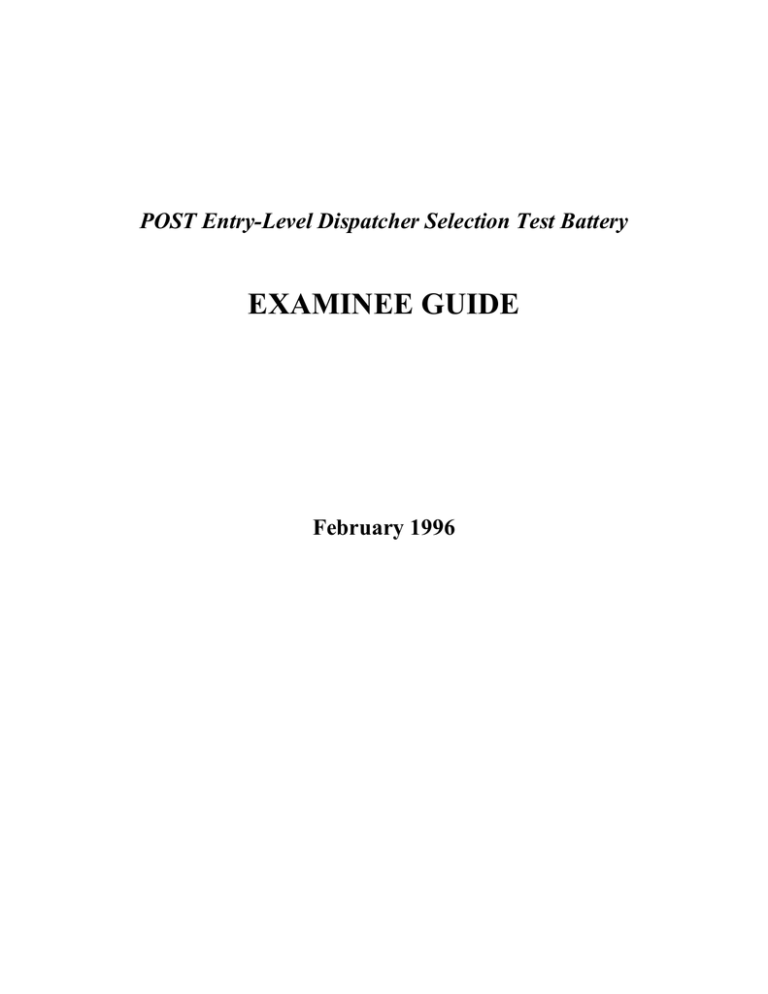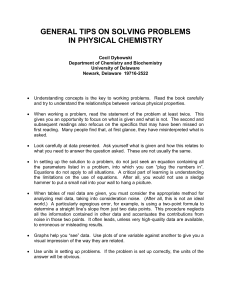EXAMINEE GUIDE
advertisement

POST Entry-Level Dispatcher Selection Test Battery EXAMINEE GUIDE February 1996 POST Entry-Level Dispatcher Selection Test Battery EXAMINEE GUIDE What the Tests Measure The POST Entry-Level Dispatcher Selection Test Battery was designed to measure your aptitude for performing public safety dispatcher work. The tests measure general abilities that are normally developed over an extended period of time. They are not designed to measure jobspecific knowledge or skills that are taught in training. The abilities measured by the tests are summarized below. Abilities Measured by the POST Entry-Level Dispatcher Selection Test Battery Verbal Ability: the ability to read and listen to information and identify facts and draw conclusions; and the ability to write clearly. Reasoning: the ability to apply general rules to specific problems to attain logical answers; and the ability to correctly follow rules to arrange things or actions in a certain order. Memory: the ability to store and retrieve facts, details, and other information. Perceptual Ability: the ability to quickly and accurately compare letters and numbers presented orally and in written form; and the ability to shift back and forth between two or more sources of information, both written and orally imparted, in performing a task. Basis for the Tests The abilities measured by the tests were identified in a statewide job analysis as being both essential for successful performance of dispatcher duties throughout California and necessary for entry-level candidates to possess before hire. The tests were constructed through an extensive process that included: review by job experts, experimental testing of over 1,000 job applicants and incumbent dispatchers, and validation research which has established that scores on the Battery are predictive of both training proficiency and job success. Page 1 Test Formats The Battery is comprised of eleven (11) brief tests. Each test is administered with its own set of instructions and is timed separately. The tests range from about 5 minutes to 15 minutes each. The entire Battery takes about 2-1/2 to 3 hours, including a short break. Six of the tests use a traditional paper-and-pencil, multiple-choice format. The remaining five tests require that you listen to information and then answer multiple-choice questions contained in a test booklet. Some of the tests require that you take notes while information is being presented. However, your notes will not be scored. Only your final answers marked on your answer sheet will be scored, so you may abbreviate your notes in any manner. Some of the tests are given with very short time limits, where speed of response is important. You should not be alarmed or discouraged if you are sometimes unable to keep up with the rapid pace of the speeded tests -- they are designed to test your limits by working up to a pace where no one can keep up. Descriptions of the test formats and sample test questions are outlined in Attachment 1. Please note that the examples are simplified versions of the actual test and are shown for illustrative purposes only. Preparing for the Test Because the tests measure general abilities, there is no study guide or reading list for this test. It is recommended that you familiarize yourself with the test formats shown in the attachment, however, it is not mandatory, as the tests will be reviewed at the testing session. If you are not accustomed to test-taking in general, or if you tend to get tense in testing situations, you may find it helpful to practice doing activities similar to those described in the attachment. All materials will be supplied for this test. There are no special materials for you to bring to complete these tests. Taking the Test When answering the test questions, keep in mind that there is no advantage to guessing at random. A fraction of a point will be subtracted from your test score for each wrong answer.1 Leaving an item blank will not count towards or against your score. A general strategy for taking this test, like most other tests, is to first answer those 1 For example, if you randomly answer 4 questions on a test that has four alternatives per question, you would be expected to answer one question correctly by chance, while answering three questions incorrectly. You would receive one point for your correct answer and lose 1/3 of a point for each incorrect answer, so your net gain would be 0 points for those 4 items. Page 2 questions that you can respond to quickly and then go back to the items that you find difficult to answer. Each of the items within a test counts the same towards your score on that particular test so you are not required to answer the questions in the order that they appear. Your Performance on the Test -- How Scores are Computed Each test in the battery receives equal weight in contributing to your total test score. Therefore, it is important to perform your best on each test. There is no advantage to trying harder on one test than another. The tests are scored on a standard scale so that your performance is evaluated relative to the performance of other examinees. In other words, your total score is not simply the number of correct responses to test questions. Rather, your total score is a combination of correct responses (minus a fraction of incorrect responses) compared to the statewide average on the tests.1 Individual hiring authorities may use the Test Battery somewhat differently in evaluating candidates. For example, some employers may use the Battery with a minimum passing score, above which all candidates are given equal consideration for admittance to an oral interview. Other employers may elect to combine candidates' Test Battery scores with other assessments in making a selection decision. As a result of how the hiring agency decides to use the Test Battery, your final score may be converted so that it may be combined with other assessments used by the agency. You should contact the hiring agency if you have questions regarding the Test Battery and its use in the agency's selection process. 1 Technically, your performance is scored relative to a normative sample of over 1,000 job applicants and non-affiliated dispatcher academy students. Your raw score (minus a fraction of incorrect responses) on each test is converted to a standard score by subtracting the norm sample mean, then dividing by the norm sample standard deviation (SD). The 11 standard scores are then summed and the total is standardized by subtracting the norm sample mean and dividing by the norm sample SD. Page 3 Attachment 1 POST Entry-Level Dispatcher Selection Test Formats 1. Public Safety Bulletin: The examinee is given 3 minutes to study a one-page "shift bulletin." The bulletin contains descriptions of several different events. After the study period, the examinee answers multiple-choice questions regarding facts and details about the events, based solely upon memory. Sample Question: The suspect was described as A. B. C. D. 30 to 35 years old. 6 feet 2 inches tall. short with a mustache. a white male. 2. Assigning Field Units: The examinee reads a novel set of rules and then determines which field unit or units should be assigned to various "incidents." The incidents occur in different geographic regions and are designated emergency or non-emergency. The examinee uses a multiple-choice response format to designate no, one, or more units to be dispatched to each incident. Sample Question: There are three field units: A, B and C. Each unit is designated to cover one or more areas as follows: Unit A - North & West Unit B - South Unit C - East Rules for assigning the field units to incidents are given below: ! Units are to be assigned only to the area(s) in which they are designated, except as noted below. ! Units are to be assigned to a call only if they are currently available. ! All available units are to be assigned to an emergency call. Now assign the appropriate field unit or units to each example incident below. In doing so, consider the above rules, along with the area, type of call and current assignments of the field units. Mark on your answer sheet the letters corresponding to all units that you assign to each incident. If an incident requires more than one unit to be assigned, you are to mark more than one letter on your answer sheet for that item. When no units are to be assigned, mark the space labeled "N" on your answer sheet for that item. Incidents: 1. Area: South Type of Call: Non-emergency Current Assignments: Unit A: Available *Unit B: Available Unit C: Available *=correct answer 2. Area: East Type of Call: Emergency Current Assignments: Unit A: Non-emergency *Unit B: Available *Unit C: Available Copyright California Commission on Peace Officer Standards & Training (1996) Page 4 Attachment 1 (continued) 3. Evaluating Facts: The examinee reads set of public safety-related facts and then determines whether conclusions that follow are true, false, or cannot be determined on the basis of the facts. Sample Question: FACTS: All crimes are to be recorded in the criminal activity log. Some vehicle accidents are crimes. Supervisors are to be notified of all crimes. CONCLUSIONS: 1. 2. Some vehicle accidents are to be recorded in the criminal activity log. (T) Supervisors are to be notified of all vehicle accidents. (F) 4. Setting Priorities: The examinee is given a novel set of rules to read and follow in order to assign priority codes to events. The events are presented in sets of three. A multiple-choice response format is used to designate the priority of events in each set as 1st, 2nd, and 3rd priority. Sample Question: Example Rules for Assigning Priorities Events are to be prioritized as follows: Code A - Highest priority: Code B - Second priority: Code C - Lowest priority: Events that involve injury or are life threatening. Events that involve property loss or damage. Other events that do not involve injury, threat to life, property loss or damage. Example set of events: Set #1: 1. A man is breaking into an unoccupied house. (B) 2. Two neighbors are currently involved in a fistfight. (A) 3. A caller is requesting information about parking permits. (C) Copyright California Commission on Peace Officer Standards & Training (1996) Page 5 Attachment 1 (continued) 5. Reading Comprehension: The examinee reads a brief passage and then answers multiple-choice questions regarding facts and details contained in the passage, as well as the meaning of the information, how it may be interpreted, and conclusions that may be drawn. Sample Question: Example Passage: Alzheimer's disease affects a person's short-term memory. The affected person may be able to easily recall information from years past, but may not recall current information such as his or her address. Alzheimer's patients exhibit a variety of behaviors, which may be construed as violations of the law. With a little careful questioning, a dispatcher can gather enough information to determine if a person's behavior is a manifestation of his or her illness, or a criminal act. Example Test Question: According to the above passage, a person with Alzheimer's disease A. *B. C. D. is likely to commit a crime. will have trouble remembering recent events. will have difficulty walking or lifting heavy objects. will have trouble remembering events that happened years ago. 6. Sentence Clarity: The examinee compares two versions of the same sentence and identifies the one that is more clearly written. Sample Question: A. The victim said that he was attacked by a man. He was riding a bicycle. *B. The victim said that he was riding a bicycle when he was attacked by a man. 7. Recalling Facts & Details: The examinee listens to a simulated call for law enforcement service received by a public safety dispatcher. The examinee is not allowed to take notes. The examinee then answers multiple-choice questions regarding various facts and details contained in the call, based solely upon memory. Sample Question: What is the name of the caller? A. B. C. D. Johnson Smith Alvarez Chin Copyright California Commission on Peace Officer Standards & Training (1996) Page 6 Attachment 1 (continued) 8. Call-Taking: The examinee listens to several simulated calls for law enforcement service received by a dispatcher. The examinee is allowed to take notes during the calls and is given a brief period to complete the notes after all calls have been presented. The examinee is allowed to use the notes to answer a series of multiple-choice questions regarding facts and details pertaining to the calls, as well as interpretations and conclusions regarding the meaning of each call. Sample Question: Where is the caller now? A. B. C. D. At her home At her office At the corner of 10th Street and Mission Avenue Across the street from the drug store 9. Oral Directions: The examinee listens to a simulated radio call from a patrol officer to a dispatcher. The examinee is allowed to take notes during the call and is given a brief period to complete the notes after the call is presented. The examinee is allowed to use the notes to answer multiple-choice questions regarding various tasks to be performed, the order in which they are to be performed, various details contained in the call such as names, times, locations, etc., and interpretations and conclusions that may be drawn. Sample Question: What instructions are you supposed to give the field technician? A. B. C. D. Be on the lookout for a knife at the scene Search the vehicle for illegal drugs Wait for the detective before entering the crime scene Forward all evidence to Sergeant Jones Copyright California Commission on Peace Officer Standards & Training (1996) Page 7 Attachment 1 (continued) 10. Checking Coded Information: The examinee listens to a series of random letternumber codes. The codes range from two to four alphanumeric characters. As each code is presented, the examinee refers to a "Code Sheet," and identifies and marks the same code among 5 written alternatives. The information is presented slowly at first, increasing in speed until the task becomes very difficult. After the information is presented, the examinee transfers his/her answers on an answer sheet. Sample Question: CODE SHEET Item Alternative Codes: item 1: 5A item 2: U1 item 3: 3g a5 1J j3 F5 UL 3B AZ L1 8c Za J1 g8 If the first code you hear is F5 then you should circle or mark F5 for item 1 on your Code Sheet. If the second code you hear is J1 then you should circle or mark J1 for item 2 on your Code Sheet. If the third code you hear is 3B then you should circle or mark 3B for item 3 on your Code Sheet. 11. Checking & Listening: The examinee performs two tasks at the same time. Task #1 is to compare a list of names, addresses, and license numbers with a "HOT SHEET" and identify as many matches as possible. Task #2 is to listen to simulated radio broadcasts from several field units and record the unit status transmissions on a "RADIO LOG." After the simulated radio broadcasts have ended, the examinee is instructed to stop the "HOT SHEET" comparison (Part 1) and answer a series of multiple-choice questions regarding the various status broadcasts of each unit (Part 2). Sample Question: Part 1: Hot Sheet Comparison: Indicate whether or not each item below matches the HOT SHEET. 1) 2) 3) 1BCD732 ACOSTA, CHARLES ACOSTA, CHERYL Part 2: Unit Status Questions: Refer to your RADIO LOG as needed to answer the following questions. 1) What was the first status reported by Unit CHARLES? A) One B) Two C) Three D) Four E) Five Copyright California Commission on Peace Officer Standards & Training (1996) Page 8




